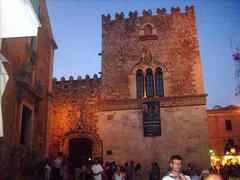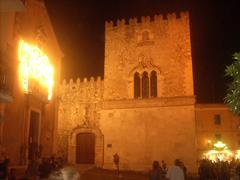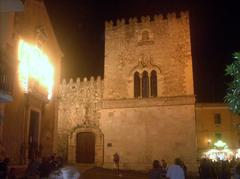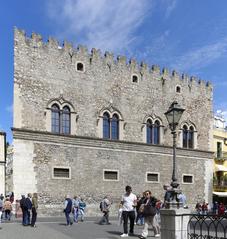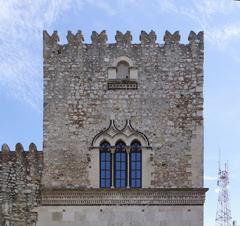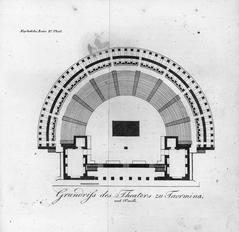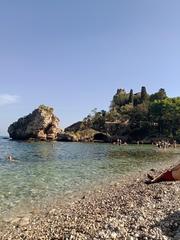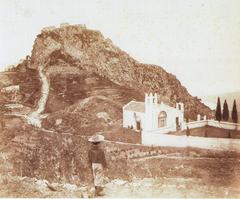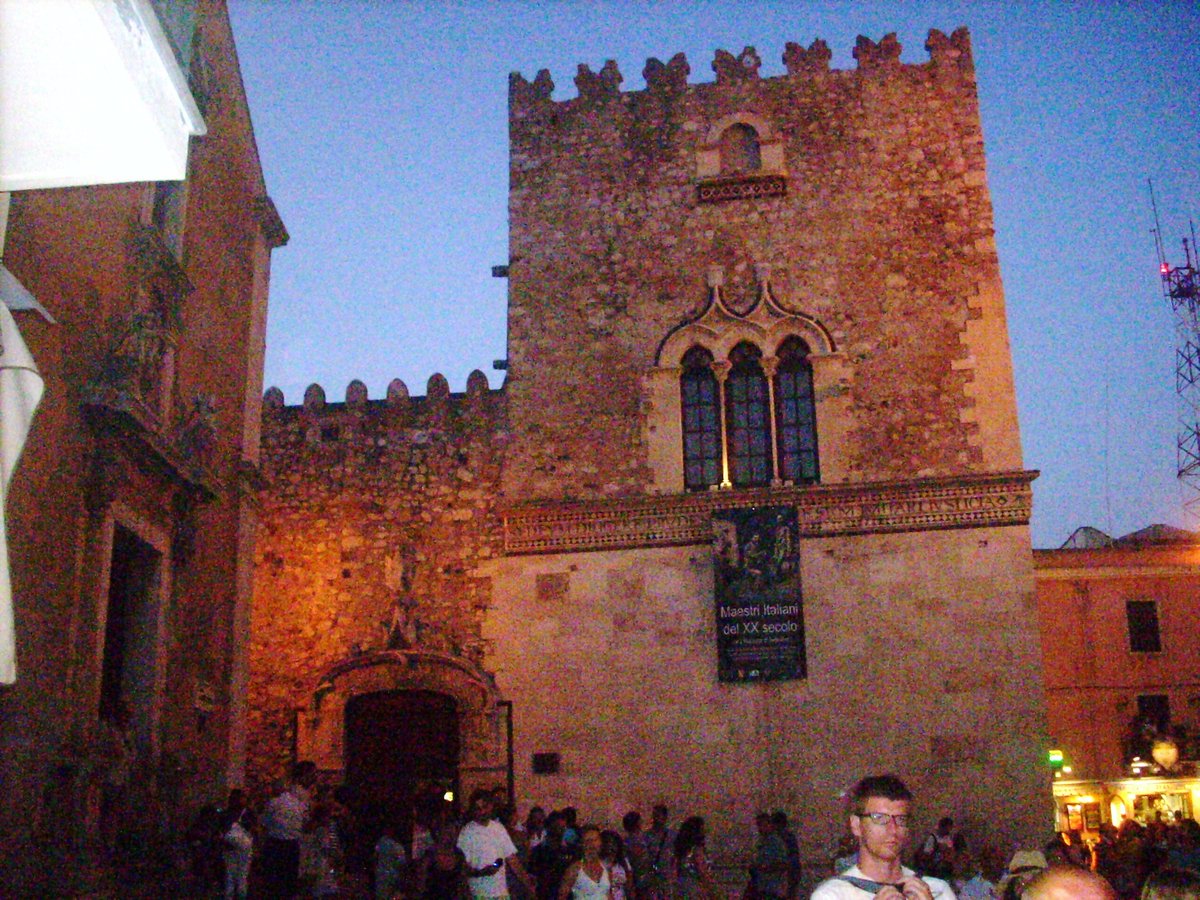
Visiting Palazzo Corvaja: Hours, Tickets, and Historical Insights
Date: 24/07/2024
Introduction
Discover the architectural and historical marvel that is Palazzo Corvaja, a treasured gem nestled in the heart of Taormina, Sicily. This comprehensive guide delves into the intricate history, architectural splendor, current exhibitions, and practical visitor information for one of Taormina’s most iconic landmarks. Palazzo Corvaja is not just a testament to medieval architecture but also a vibrant cultural center that continues to captivate visitors from around the world. From its origins in the Arab era to its role as the seat of the Sicilian Parliament, Palazzo Corvaja offers a rich tapestry of history that reflects the diverse cultural influences that have shaped Taormina over the centuries (Travel Taormina). Whether you’re a history enthusiast, an art lover, or simply a curious traveler, this guide provides all the information you need to make the most of your visit to Palazzo Corvaja.
Table of Contents
- Introduction
- Historical Overview and Architectural Significance
- Current Use and Exhibitions
- Visitor Information
- Travel Tips and Nearby Attractions
- Educational Programs and Future Exhibitions
- Seasonal Considerations
- Safety and Etiquette
- Language
- Emergency Contacts
- FAQ
- Conclusion
Historical Overview and Architectural Significance
Origins and Early History
Palazzo Corvaja, located in Taormina, Sicily, is a remarkable example of medieval architecture that has evolved through various historical periods. The earliest part of the palace, a cubic tower, was constructed during the Arab era between 902 and 1079. This tower was initially built on the ruins of a Roman forum, serving as a fortification for the town (Travel Taormina). The Arabs, who ruled Sicily from the 9th to the 11th century, designed the tower to resemble the sacred Kaaba in Mecca, reflecting their cultural and religious influences (Taormina.it).
Architectural Evolution
The architectural style of Palazzo Corvaja is a fascinating amalgamation of different influences due to the various periods during which it was built and extended. The original Arab tower was expanded in the 13th century with the addition of a new wing and a staircase leading from the courtyard to the first floor. This staircase features three high-relief panels in Siracusa stone, depicting scenes from the Creation of Eve, the Original Sin, and the Expulsion from Paradise (CityMap Sicilia).
In the 14th century, the palace was further enlarged, incorporating Norman and Gothic architectural elements. The principal floor of the palace features pairs of lancet windows divided by columns, a characteristic of Gothic architecture. The courtyard walls are adorned with reliefs illustrating the Creation, adding to the palace’s artistic and historical significance (Wikipedia).
The Sicilian Parliament
One of the most significant historical events associated with Palazzo Corvaja is its role as the seat of the Sicilian Parliament in 1411. The parliament convened in the large 15th-century hall, which was built in Norman style, to elect the King of Sicily in the presence of Queen Bianca of Navarra, the regent of the kingdom (Taormina.it). This event underscores the palace’s importance in the political history of Sicily.
The Corvaja Family
The palace is named after the Corvaja family, one of the oldest and most noble families in Taormina. The Corvaja family owned the palace from 1538 until 1945, during which time they made several modifications and additions to the building. The facade of the palace, constructed in Taormina stone and black lava stone, features mullioned windows with Corinthian capitals and crown battlements, reflecting the family’s wealth and influence (CityMap Sicilia).
Restoration and Modern Use
By the end of World War II, Palazzo Corvaja had fallen into a state of neglect, with multiple families living in the building simultaneously. In 1945, the first mayor of Taormina had the building dispossessed, and Armando Dillon, a Neapolitan architect, was commissioned to restore it. The restoration work, which lasted from 1945 to 1948, aimed to preserve the historical and architectural integrity of the palace (Taormina.it).
Current Use and Exhibitions
Current Use of Palazzo Corvaja
Today, Palazzo Corvaja stands as a vibrant cultural center, hosting a variety of exhibitions and events. Its multifaceted role includes serving as a tourist information center, making it a must-visit for both locals and tourists. The palazzo’s blend of historical charm and modern functionality offers a unique venue for cultural activities.
Luigi Ontani’s “Le Ore” Exhibition
One of the standout exhibitions currently on display is Luigi Ontani’s “Le Ore,” running from June 23 to July 28, 2024, in collaboration with Museo MAXXI. Ontani’s work delves into the fluidity of identity and time, offering a visual journey that challenges perceptions (Taobuk).
Exhibition Highlights
- Theme: The fluidity of identity and time is the central theme, explored through various media to create a layered narrative.
- Artistic Approach: Ontani’s iconographic richness and nomadic quality blend traditional and contemporary art forms.
- Visitor Experience: The immersive exhibition encourages personal engagement, with interactive and multimedia installations enhancing the experience.
Other Exhibitions and Events
Beyond “Le Ore,” Palazzo Corvaja hosts numerous other exhibitions and events throughout the year, often in collaboration with prestigious institutions like Museo MAXXI.
- Rita Sabo’s “Sacred Planet”: This upcoming exhibition explores humanity’s relationship with nature through environmental themes and installations (MAXXI).
- Passeggiate Romane: A guided tour through Rome’s history, featuring sets by Dante Ferretti, enriching the visitor experience (MAXXI).
Visitor Information
Opening Hours
Generally open from 10 AM to 6 PM. Check the official website or contact the tourist center for updates.
Tickets
Ticket prices vary per exhibition. For “Le Ore,” purchase online or at the venue. Discounts available for students, seniors, and groups.
Guided Tours
Enhance your visit with guided tours offering deep insights into exhibitions and the palazzo’s history.
Accessibility
Equipped for visitors with disabilities, including special tours and tactile visits for the visually impaired (MAXXI).
Travel Tips and Nearby Attractions
Getting There
Taormina is accessible by train, car, or bus. The Palazzo is centrally located, making it easy to reach.
Nearby Attractions
While in Taormina, visit the Ancient Theatre, Isola Bella, and the Taormina Cathedral for a full historical and cultural experience.
Photographic Spots
The palazzo’s architecture and the surrounding historical sites offer excellent photography opportunities.
Educational Programs and Future Exhibitions
Palazzo Corvaja offers educational programs, including workshops, lectures, and interactive sessions for all ages. Future exhibitions include:
- “Nuove Avventure Sotterranee”: Exploring underground landscapes and their cultural significance (MAXXI).
- “Quintessenza”: Featuring works by Grazzini, Tonazzini, and Colombo, focusing on the essence of artistic expression (MAXXI).
Seasonal Considerations
Taormina has a Mediterranean climate, with hot summers and mild winters. The peak tourist season is from June to August. For a quieter experience, visit in spring (April to June) or autumn (September to October), when the weather is pleasant, and crowds are thinner.
Safety and Etiquette
While Taormina is generally safe, take standard precautions, such as keeping an eye on your belongings in crowded areas. Respect local customs and dress codes at religious sites.
Language
Italian is the primary language, but English is widely understood in tourist areas. Learning a few basic Italian phrases can enhance your experience and is appreciated by locals.
Emergency Contacts
In case of emergencies, dial 112. The Tourist Information Office at Palazzo Corvaja can also provide assistance.
FAQ
- What are the opening hours of Palazzo Corvaja? Generally from 10 AM to 6 PM, but check the official website for the latest information.
- How much do tickets cost? Prices vary by exhibition. Discounts are available for students, seniors, and groups.
- Is the venue accessible? Yes, with facilities for visitors with disabilities and special tours for the visually impaired.
Conclusion
A visit to Palazzo Corvaja in Taormina is a journey through time, offering a unique blend of historical and cultural experiences. From its medieval origins and architectural evolution to its current role as a cultural hub, Palazzo Corvaja stands as a beacon of Taormina’s rich heritage. The palace’s diverse exhibitions and events, such as Luigi Ontani’s “Le Ore” and upcoming showcases like Rita Sabo’s “Sacred Planet”, provide visitors with a dynamic and immersive cultural experience (Taobuk). Practical information, including visiting hours, ticket prices, and travel tips, ensures that visitors can plan their visit efficiently and enjoy all that Palazzo Corvaja has to offer. Whether exploring its historical significance, appreciating its architectural beauty, or participating in its cultural programs, Palazzo Corvaja promises an enriching and memorable experience for all who visit (CityMap Sicilia).
References
- Travel Taormina. (n.d.). Palazzo Corvaja. Retrieved from Travel Taormina
- Taormina.it. (n.d.). Palazzo Corvaja. Retrieved from Taormina.it
- CityMap Sicilia. (n.d.). Corvaja Palace - Sicilian Museum of Art and Popular Traditions. Retrieved from CityMap Sicilia
- Wikipedia. (n.d.). Palazzo Corvaja. Retrieved from Wikipedia
- Taobuk. (n.d.). Inaugurazione Luigi Ontani “Le Ore”. Retrieved from Taobuk
- MAXXI. (n.d.). Retrieved from MAXXI
